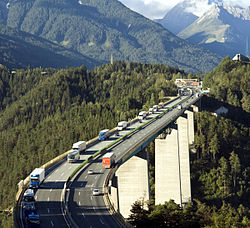This article is tourism topic.

Europabrücke in Austria, a major transport route from Central Europe to Italy
Before leaving
- Make sure your car is in good condition. Check belts, fluids and make sure the tires are at the correct pressure.
- Find out about the conditions of the trip (condition of science, weather)
- Plan ahead. Know where you will stop to refuel, where rest breaks will be taken, how long the trip will take, and in the event of major accidents and queues, alternative routes.
- Pack the car correctly. Place your luggage so that it does not fly around the car during sudden braking.
- Keep available the items you need such as passports, driver’s license, money, coins for parking and tolls.
- Check that the car is refueled - refuel whenever possible.
When you drive
- Follow local traffic regulations.
- Do not drive the same length for too long. Take a break after driving up to 250 kilometers or two hours (depending on the condition of the road and your speed).
- Stop if you get tired and take a break or sleep a little and let others run in between.
- Be patient, it is better to get there late when never.
- Follow the two-second rule. Keep a safety distance of two seconds for the car in front or four seconds if there is slippery or heavy traffic.
- If you drive slowly or pull a caravan, give way and let those coming from behind pass, especially if a queue starts to form behind you.
When you stop
- Stop in a safe place, not in the lane, but use rest areas or parking spaces where possible
- Before locking the car, make sure the key is included, don’t just press the lock button and hit the door.
- Before leaving the car, make sure the place is safe. Make sure the lights are off, valuables out of sight of thieves and that the car is securely parked with the wheels facing the sidewalk if you stop on a hill. Make a note of where you parked if you are in a parking area or unfamiliar area and check for parking restrictions, if any.
If the car breaks down
- Try to get out of the lane before the car stops.
- If the tire has burst, consider driving slowly to the nearest rest area if there is no room to stop at the side of the road.
- Turn on the hazard warning lights if there are any in your car.
- Stop the engine and apply the parking brake.
- Warn other traffic. Check your local traffic regulations for the most appropriate way. Opening the hood is one way.
- Stay with your car but so that you do not stand in traffic.
- Get help - call the police or traffic authorities and your local roadside assistance on your mobile phone if you are unable to rectify the fault yourself.
In many countries, the use of a warning triangle is mandatory in the event of an accident. It is not everywhere provided by law but still always good to use. Leave the triangle at least 50 meters behind the car, on the highways 100 meters. It reduces the risk of being run over if you have had to stop in a dangerous place. You should also keep a tow rope and starter cables in the car.
Crossing borders
Check with the consulates of both borders if there are any special requirements to cross the border by car (e.g. In Argentina rental cars are not allowed to leave the country) .In some cases Carnet de Passage required.
